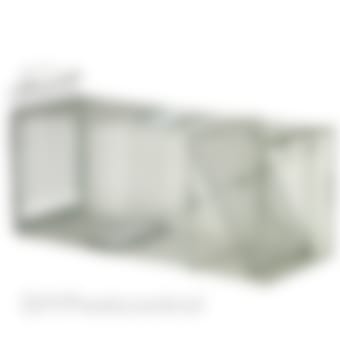Raccoon Control

How To Prevent Raccoon Entry Into Chimneys
Raccoons can access rooftops because they can climb trees, vines and downspouts. They use their climbing ability to enter chimneys. Loose shingles and holes near the eaves of the roof need to be repaired. Trimming trees and shrubs may be useful in limiting their access.
Raccoons Getting Into Garbage Cans
Put tight fitting tops on garbage cans; this will keep out most raccoons. If the cans are tipped over, it may be necessary to wire the garbage cans shut. Place the garbage cans on a rack to prevent them from tipping over.
Excluding Raccoons
When excluding raccoons from your house during the spring or summer months, be careful not to seal any young raccoons inside. If you seal them inside, it may cause painful death and cause more damage to the structure. The average age of a young raccoon that leaves the nest is 10-14 weeks. Raccoons have one litter a year, ranging from 3-6 young raccoons.
Trapping Raccoons
Using live traps with bait inside the traps is the best method to remove raccoons from buildings. Use bait such as fish, fresh vegetables, cat food, chicken parts, bacon, corn and sardines. Change the bait every few days.
Raccoon Traps and Trapping
We carry Havahart Live Traps for trapping Raccoons, use either Havahart #1079, Havahart #1085, or Safeguard #52830. These live traps provide a secure and safe way to catch unwanted raccoons on your property. The Safequard #5280 trap has an added feature of a rear release door for easier baiting and releasing of the trapped animal.
- It is advisable to set multiple traps in different locations. It is common for several families of raccoons to live in one garage or attic. A minimum of two to three raccoon traps is best. Place traps in areas of highest activity. If the raccoons are inhabiting buildings, place traps near the garbage cans, near den entrances located in crawlspaces or basements, and at tree bases that may serve as connection trails to the roof and chimney. Raccoons follow similar paths to enter buildings on each return visit. Typical routes are along fence lines, building perimeters, and beneath available shrubs. If the raccoons are getting into your garbage cans, place the traps near the tipped-over cans.
- Check traps in the morning and release trapped raccoons as soon as possible. Check your local wildlife department to see if they are a protected animals and release them at least 10 miles in distance from the structure.
- Some raccoons enter a live raccoon trap easily; other raccoons are suspicious for several days. Encourage wary raccoons to enter the trap by setting up a natural footing of earth on the bottom of the trap. Push the trap back and forth on the ground, and working the bottom of the trap into the earth accomplishes a natural setting. If the traps are placed near their dens or paths, it is best to disguise the live traps with branches, twigs leaves other natural features.
- If you pre-bait the raccoon trap, this encourages wary raccoons to enter the trap. Pre-bait by placing baits in front of, and around the trap keeping the trap door tied open for a couple of days. This allows raccoons to enter the strange metal object and feed freely.
- Raccoons are attracted to shiny objects. Place some wadded-up aluminum foil in the trap to make them curious.
- Raccoons have long "fingers" that can pry open garbage cans as well as reach into the trap in order to steal the bait. Place logs or stones on the sides of the traps. Some raccoons will shake the trap in order to release the bait. It is helpful to stake down the trap with tent stakes.
Baiting Tips
- Wash yourself with soap and hot water to remove all scent and place the trap outdoors for several days.
- Use gloves when handling trap to prevent human scent from transferring to trap.
- Use small amounts of bait leading to the trap in a trail. Place most of the bait at the back end or closed end of the trap.
- Bait for raccoons includes fish, sweet corn, crisp bacon and marshmallows. Vanilla wafers, marshmallows, peanut butter, whole raw eggs and twinkies are attractive to raccoons, but not to cats.
Raccoon's Biology, Habitat, Diet and Danger
| Description |
The adult raccoon can weigh between 12-25 pounds, with a total length of 24-46 inches. Raccoons are usually active at night. If seen during the day, most likely it is injured or sick. Do not approach raccoons, rather catch them in a live cage. Raccoons are members of the bear family and are strong. |
|---|---|
| Habitat |
. Raccoons prefer water and swampy areas. Raccoons are found throughout the USA. They can use hollow trees, rock crevices, and abandoned animal burrows for dens. In and around homes, they can habitat in attics, chimneys, under porches, etc.
|
| Diet | Their diet consists of insects, frogs, fish, crayfish, mussels, fruits, berries, nuts, and grains. They regularly raid garbage cans left outside. |
| Biology | the Mating season is between January to March with a 63-day gestation period. One litter has between one to seven in number. This family group remains together for about one year. Raccoons seldom live more than seven years in the wild. |
| Danger | Raccoons can contract and transfer diseases. Rabies is the biggest danger and concern. They are not normally aggressive towards humans but will defend their young. |













